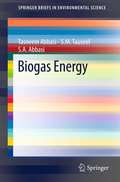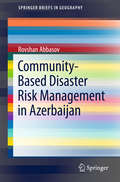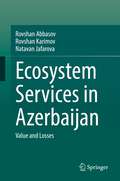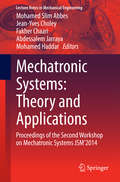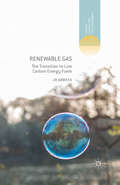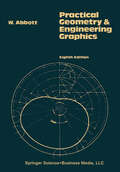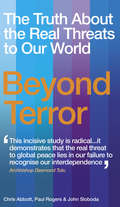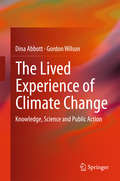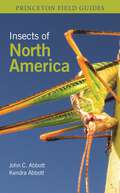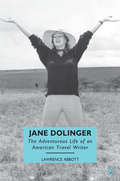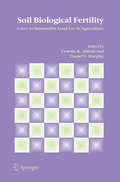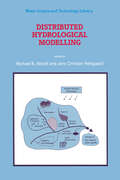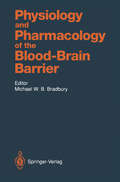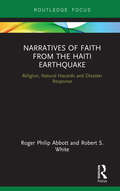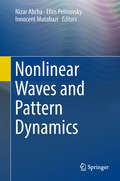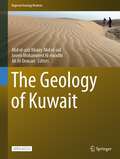- Table View
- List View
Biogas Energy (SpringerBriefs in Environmental Science #2)
by Tasneem Abbasi S.M. Tauseef S.A. AbbasiIn recent years, the importance of biogas energy has risen manifold and has become universal. This is due to the realization that biogas capture and utilization has great potential in controlling global warming. By capturing biogas wherever it is formed, we not only tap a source of clean energy, but we also prevent the escape of methane to the atmosphere. Given that methane has 25 times greater global warming potential than CO2, methane capture through biogas energy in this manner can contribute substantially towards global warming control.
Community-Based Disaster Risk Management in Azerbaijan (SpringerBriefs in Geography)
by Rovshan AbbasovThis book illustrates the main factors of vulnerability and gives a clear picture about the possible interventions to reduce disaster risks both in schools and communities in Azerbaijan. A new methodology for child centered vulnerability assessments both on school and community levels has been developed. This methodology can be used to assess the level of vulnerability of schools and communities. The book is a newly prepared training manual which will help practitioners conduct trainings for government and community organizations. While the book is focused on a specific region, the suggested approach is generic and can be used elsewhere.
Ecosystem Services in Azerbaijan: Value and Losses
by Rovshan Abbasov Rovshan Karimov Natavan JafarovaThis book aims to draw readers' attention to the benefits once present nature in Azerbaijan. Over the past hundred years, much of this has been lost because of the neglect of the intrinsic values of nature by both managers and local authorities, and the overuse of natural resources. For example, oil pollution and overfishing in the Caspian Sea have almost destroyed its fish and caviar resources. In this volume, the authors distinguish between the concepts of "gain" and "income" and show readers that short-term benefits based solely on monetary income deprive people and nature itself of long-term, lasting value. The book provides readers with real historical information, discusses the interactions between humans and nature, and shows, with real data and trends, the consequences of anthropogenic activity on natural resources in Azerbaijan. The authors cover fish, water, forest, mountain, and pasture ecosystems, draw attention to the impacts that pollution and other forms of environmental degradation have had on these resources, and the show the impact that resource depletion on people’s livelihoods. The book is intended primarily for managers, policymakers, students, and academics, and will be of interest to natural scientists, historians, and students of culture.
Mechatronic Systems: Proceedings of the Second Workshop on Mechatronic Systems JSM’2014 (Lecture Notes in Mechanical Engineering)
by Mohamed Slim Abbes Jean-Yves Choley Fakher Chaari Abdessalem Jarraya Mohamed HaddarThe book offers a snapshot of the state-of-art in the field of model-based mechatronic system design. It covers topics including machine design and optimization, predictive systems in manufacturing networks, and the development of software for modeling and simulation of processes, which are supplemented by practical case studies. The book is a collection of fifteen selected contributions presented during the Workshop on Mechatronic Systems, held on March 17-19, 2014, in Mahdia, Tunisia. The workshop was jointly organized by the Laboratory of Mechanics Modeling and Production (LA2MP) of the National School of Engineers Sfax, Tunisia, and the Laboratory for Mechanical Systems and Materials Engineering (LISMMA) of Higher Institute of Mechanics (SUPMECA), Paris, France.
Renewable Gas: The Transition to Low Carbon Energy Fuels (Energy, Climate and the Environment)
by Jo AbbessThe author looks at the prospects for a transition from natural gas to low carbon gas, which could take several decades, and at how this will depend on the evolution of the fossil fuel industry. She investigates the technologies and energy systems for making the best use of renewable gas resources.
Practical Geometry and Engineering Graphics: A Textbook for Engineering and Other Students
by W. AbbotHIS BOOK IS INTENDED TO PROVIDE A COURSE IN PRACTICAL Geometry for engineering students who have already received some instruction in elementary plane geometry, graph plotting, and the use T of vectors. It also covers the requirements of Secondary School pupils taking Practical Geometry at the Advanced Level. The grouping adopted, in which Plane Geometry is dealt with in Part I, and Solid or Descriptive Geometry in Part II, is artificial, and it is the intention that the two parts should be read concurrently. The logical treatment of the subject presents many difficulties and the sequence of the later chapters in both parts is necessarily a compromise; as an illustration, certain of the more easy inter sections and developments might with advantage be taken at an earlier stage than that indicated. In Part I considerable space has been devoted to Engineering Graphics, particularly to the applications of graphical integration. The use of graphical methods of computation is fully justified in most engineering problems of a practical nature-especially where analytical methods would prove laborious -the results obtained being as accurate as the data warrant.
Why We Eat, How We Eat: Contemporary Encounters between Foods and Bodies (Critical Food Studies)
by Emma-Jayne Abbots Anna LavisWhy We Eat, How We Eat maps new terrains in thinking about relations between bodies and foods. With the central premise that food is both symbolic and material, the volume explores the intersections of current critical debates regarding how individuals eat and why they eat. Through a wide-ranging series of case studies it examines how foods and bodies both haphazardly encounter, and actively engage with, one another in ways that are simultaneously material, social, and political. The aim and uniqueness of this volume is therefore the creation of a multidisciplinary dialogue through which to produce new understandings of these encounters that may be invisible to more established paradigms. In so doing, Why We Eat, How We Eat concomitantly employs eating as a tool - a novel way of looking - while also drawing attention to the term 'eating' itself, and to the multiple ways in which it can be constituted. The volume asks what eating is - what it performs and silences, what it produces and destroys, and what it makes present and absent. It thereby traces the webs of relations and multiple scales in which eating bodies are entangled; in diverse and innovative ways, contributors demonstrate that eating draws into relationships people, places and objects that may never tangibly meet, and show how these relations are made and unmade with every mouthful. By illuminating these contemporary encounters, Why We Eat, How We Eat offers an empirically grounded richness that extends previous approaches to foods and bodies.
Why We Eat, How We Eat: Contemporary Encounters between Foods and Bodies (Critical Food Studies)
by Emma-Jayne Abbots Anna LavisWhy We Eat, How We Eat maps new terrains in thinking about relations between bodies and foods. With the central premise that food is both symbolic and material, the volume explores the intersections of current critical debates regarding how individuals eat and why they eat. Through a wide-ranging series of case studies it examines how foods and bodies both haphazardly encounter, and actively engage with, one another in ways that are simultaneously material, social, and political. The aim and uniqueness of this volume is therefore the creation of a multidisciplinary dialogue through which to produce new understandings of these encounters that may be invisible to more established paradigms. In so doing, Why We Eat, How We Eat concomitantly employs eating as a tool - a novel way of looking - while also drawing attention to the term 'eating' itself, and to the multiple ways in which it can be constituted. The volume asks what eating is - what it performs and silences, what it produces and destroys, and what it makes present and absent. It thereby traces the webs of relations and multiple scales in which eating bodies are entangled; in diverse and innovative ways, contributors demonstrate that eating draws into relationships people, places and objects that may never tangibly meet, and show how these relations are made and unmade with every mouthful. By illuminating these contemporary encounters, Why We Eat, How We Eat offers an empirically grounded richness that extends previous approaches to foods and bodies.
Beyond Terror: The Truth About the Real Threats to Our World
by Chris Abbott John Sloboda Paul RogersIs international terrorism really the single greatest threat to world security?Since the 9/11 attacks, many Western governments assume terrorism to be the greatest threat we face. In response, their dangerous policies attempt to maintain control and keep the status quo by using overwhelming military force. This important book shows why this approach has been such a failure, and how it distracts us from other, much greater, threats of climate change, competition over resources, marginalisation of the majority of the world and global militarisation.Unless urgent, coordinated action is taken in the next 5-10 years on all these issues it will be almost imossible to avoid the earth becoming a highly unstable place by the middle years of this century. Beyond Terror offers an alternative path for politicians, journalists and concerned citizens alike.
Carbohydrate-Protein Interactions: Methods and Protocols (Methods in Molecular Biology #2657)
by D. Wade Abbott Wesley F. ZandbergThis second edition provides new and updated tools for studying protein-carbohydrate interactions ranging from traditional biochemical methods to state-of-the-art techniques. This book focuses on four different research themes detailing methods for screening and quantifying CAZyme activity, investigating the interactions between proteins, carbohydrate ligands, methods for the visualization of carbohydrates, protein-carbohydrate complexes, structural and “omic” approaches for studying systems of CAZymes. Written in the format of the highly successful Methods in Molecular Biology series, each chapter includes an introduction to the topic, lists necessary materials and methods, includes tips on troubleshooting and known pitfalls, and step-by-step, readily reproducible protocols. Authoritative and cutting-edge, Carbohydrate- Protein Interactions: Methods and Protocols, Second Edition aims to be comprehensive guide for researchers in the field.
The Lived Experience of Climate Change: Knowledge, Science and Public Action
by Dina Abbott Gordon WilsonThis book explores the idea that daily lived experiences of climate change are a crucial missing link in our knowledge that contrasts with scientific understandings of this global problem. It argues that both kinds of knowledge are limiting: the sciences by their disciplines and lived experiences by the boundaries of everyday lives. Therefore each group needs to engage the other in order to enrich and expand understanding of climate change and what to do about it.Complemented by a rich collection of examples and case studies, this book proposes a novel way of generating and analysing knowledge about climate change and how it may be used. The reader is introduced to new insights where the book:• Provides a framework that explains the variety of simultaneous, co-existing and often contradictory perspectives on climate change.• Reclaims everyday experiential knowledge as crucial for meeting global challenges such as climate change.• Overcomes the science-citizen dichotomy and leads to new ways of examining public engagement with science. Scientists are also human beings with lived experiences that filter their scientific findings into knowledge and actions.• Develops a ‘public action theory of knowledge’ as a tool for exploring how decisions on climate policy and intervention are reached and enacted.While scientists (physical and social) seek to explain climate change and its impacts, millions of people throughout the world experience it personally in their daily lives. The experience might be bad, as during extreme weather, engender hostility when governments attempt mitigation, and sometimes it is benign. This book seeks to understand the complex, often contradictory knowledge dynamics that inform the climate change debate, and is written clearly for a broad audience including lecturers, students, practitioners and activists, indeed anyone who wishes to gain further insight into this far-reaching issue.
Insects of North America (Princeton Field Guides #157)
by Dr. John C. Abbott Kendra K. AbbottThe ultimate photographic field guide to North American insectsThis amazing field guide enables you to identify all 783 families of insects currently recognized in the United States and Canada. Richly illustrated with more than 3,700 stunning photos along with keys to families for many of the orders, Insects of North America features a comprehensive introduction that discusses classification and nomenclature, insect diversity, global threats, the latest collecting and curatorial techniques, and the many ways these remarkable organisms impact society. Combined with in-depth taxonomic coverage, this is the essential resource for both professionals and amateurs interested in the most diverse group of animals on the planet.Covers all 783 insect families known to occur in the United States and CanadaFeatures more than 3,700 color photos, with nearly every photo identified to species levelIncludes an illustrated glossary for easy reference in the fieldThe first field companion of its kind since the publication of the Peterson guide in 1970Ideal for entomology courses of all levelsAn invaluable resource for anyone interested in insects
The Stability of the Differentiated State (Results and Problems in Cell Differentiation #1 )
by Joan AbbottJane Dolinger: The Adventurous Life of an American Travel Writer
by L. AbbottFor almost forty years, Jane Dolinger traveled the world and wrote about her adventures, from the Amazon jungle to the sands of the Sahara. She produced eight books and more than a thousand articles between 1955 and 1995, and she also earned a reputation as a glamorous celebrity and model. Jane Dolinger was an anomaly in her time, a dynamic and attractive woman with an impressive literary talent, a woman who lived and documented a most unconventional and inspirational life. Sometimes controversial but always outstanding, Jane was a pioneer among women and writers. Here for the first time, her life and work are studied in a thoroughly researched yet entertaining literary biography.
Soil Biological Fertility: A Key to Sustainable Land Use in Agriculture
by Lynette K. Abbott Daniel V. MurphyIt is becoming more relevant to explore soil biological processes in terms of their contribution to soil fertility. This book presents a comprehensive scientific overview of the components and processes that underpin the biological characteristics of soil fertility. It highlights the enormous diversity of life in soil and the resulting effects that management of land can have on the contribution of this diverse community to soil fertility in an agricultural context.
Distributed Hydrological Modelling (Water Science and Technology Library #22)
by Michael B. Abbott Jens Christian RefsgaardIt is the task of the engineer, as of any other professional person, to do everything that is reasonably possible to analyse the difficulties with which his or her client is confronted, and on this basis to design solutions and implement these in practice. The distributed hydrological model is, correspondingly, the means for doing everything that is reasonably possible - of mobilising as much data and testing it with as much knowledge as is economically feasible - for the purpose of analysing problems and of designing and implementing remedial measures in the case of difficulties arising within the hydrological cycle. Thus the aim of distributed hydrologic modelling is to make the fullest use of cartographic data, of geological data, of satellite data, of stream discharge measurements, of borehole data, of observations of crops and other vegetation, of historical records of floods and droughts, and indeed of everything else that has ever been recorded or remembered, and then to apply to this everything that is known about meteorology, plant physiology, soil physics, hydrogeology, sediment transport and everything else that is relevant within this context. Of course, no matter how much data we have and no matter how much we know, it will never be enough to treat some problems and some situations, but still we can aim in this way to do the best that we possibly can.
Physiology and Pharmacology of the Blood-Brain Barrier (Handbook of Experimental Pharmacology #103)
by N. J. Abbott D. Barnes D. J. Begley A. L. Betz Michael W.B. Bradbury M. W. Brightman D. J. Brooks H. F. Cserr P. A. Fraser A. Gjedde G. W. Goldstein J. Greenwood N. H. Greig M. K. Gumerlock J. J. Laterra J-M. Lefauconnier P. J. Luthert D. K. Male E. A. Neuwelt C. S. Patlak O. E. Pratt S. I. Rapoport P. J. Robinson N. R. Saunders G. P. Schielke Q. R. SmithThe blood-brain barrier is still not completely understood and therefore the subject of fascinating study. How are endogenous substances transported through the blood-brain barrier? What are the known therapeutic and toxic agents? How are they transported across cerebral microvessels? The discussion of these and other questions with far-reaching consequences for all neuroscientists can be found in this volume. This authoritative and up-to-date review of the blood-brain barrier gives a proper understanding of the topic. The experimental principles, the results of very recent research, as well as the implications that experimental research has for clinical treatment are thoroughly covered. Information is given on: - new findings based on classical physiological and pharmacological techniques, - results obtained from brain capillaries in vitro and in culture, - results obtained from the new scanning techniques (PET and MRI), - the immunology of the blood-brain barrier, - trace metal transport, - the pathological breakdown of the barrier and - the modification of drugs to increase their entry into the brain. Here is a source of information that is invaluable to specialists concerned with basic research in the neurosciences, with the design of neuropharmacological agents, with the radiological diagnosis of cerebral pathology or with the treatment of cerebral lesions!
Narratives of Faith from the Haiti Earthquake: Religion, Natural Hazards and Disaster Response (Routledge Focus on Religion)
by Roger Philip Abbott Robert S. WhiteThis book presents an in-depth ethnographic case study carried out in the years following the 2010 Haiti earthquake to present the role of faith beliefs in disaster response. The earthquake is one of the most destructive on record, and the aftermath, including a cholera epidemic and ongoing humanitarian aid, has continued for years following the catastrophe. Based on dozens of interviews, this book gives primacy to survivors’ narratives. It begins by laying out the Haitian context, before presenting an account of the earthquake from survivors’ perspectives. It then explores in detail how the earthquake affected the religious, mainly Christian, faith of survivors and how religious faith influenced how they responded to, and are recovering from, the experience. The account is also informed by geoscience and the accompanying "complicating factors." Finally, the Haitian experience highlights the significant role that religious faith can play alongside other learned coping strategies in disaster response and recovery globally. This book contributes an important case study to an emerging literature in which the influence of both religion and narrative is being recognised. It will be of interest to scholars of any discipline concerned with disaster response, including practical theology, anthropology, psychology, geography, Caribbean studies and earth science. It will also provide a resource for non-governmental organisations.
Narratives of Faith from the Haiti Earthquake: Religion, Natural Hazards and Disaster Response (Routledge Focus on Religion)
by Roger Philip Abbott Robert S. WhiteThis book presents an in-depth ethnographic case study carried out in the years following the 2010 Haiti earthquake to present the role of faith beliefs in disaster response. The earthquake is one of the most destructive on record, and the aftermath, including a cholera epidemic and ongoing humanitarian aid, has continued for years following the catastrophe. Based on dozens of interviews, this book gives primacy to survivors’ narratives. It begins by laying out the Haitian context, before presenting an account of the earthquake from survivors’ perspectives. It then explores in detail how the earthquake affected the religious, mainly Christian, faith of survivors and how religious faith influenced how they responded to, and are recovering from, the experience. The account is also informed by geoscience and the accompanying "complicating factors." Finally, the Haitian experience highlights the significant role that religious faith can play alongside other learned coping strategies in disaster response and recovery globally. This book contributes an important case study to an emerging literature in which the influence of both religion and narrative is being recognised. It will be of interest to scholars of any discipline concerned with disaster response, including practical theology, anthropology, psychology, geography, Caribbean studies and earth science. It will also provide a resource for non-governmental organisations.
Resistive Gaseous Detectors: Designs, Performance, and Perspectives
by Marcello Abbrescia Vladimir Peskov Paulo FonteThis first book to critically summarize the latest achievements and emerging applications within this interdisciplinary topic focuses on one of the most important types of detectors for elementary particles and photons: resistive plate chambers (RPCs). In the first part, the outstanding, international team of authors comprehensively describes and presents the features and design of single and double-layer RPCs before covering more advanced multi-layer RPCs. The second part then focuses on the application of RPCs in high energy physics, materials science, medicine and security. Throughout, the experienced authors adopt a didactic approach, with each subject presented in a simple way, increasing in complexity step by step.
Resistive Gaseous Detectors: Designs, Performance, and Perspectives
by Marcello Abbrescia Vladimir Peskov Paulo FonteThis first book to critically summarize the latest achievements and emerging applications within this interdisciplinary topic focuses on one of the most important types of detectors for elementary particles and photons: resistive plate chambers (RPCs). In the first part, the outstanding, international team of authors comprehensively describes and presents the features and design of single and double-layer RPCs before covering more advanced multi-layer RPCs. The second part then focuses on the application of RPCs in high energy physics, materials science, medicine and security. Throughout, the experienced authors adopt a didactic approach, with each subject presented in a simple way, increasing in complexity step by step.
Nonlinear Waves and Pattern Dynamics
by Nizar Abcha Efim Pelinovsky Innocent MutabaziThis book addresses the fascinating phenomena associated with nonlinear waves and spatio-temporal patterns. These appear almost everywhere in nature from sand bed forms to brain patterns, and yet their understanding still presents fundamental scientific challenges. The reader will learn here, in particular, about the current state-of-the art and new results in: Nonlinear water waves: resonance, solitons, focusing, Bose-Einstein condensation, as well as and their relevance for the sea environment (sea-wind interaction, sand bed forms, fiber clustering) Pattern formation in non-equilibrium media: soap films, chimera patterns in oscillating media, viscoelastic Couette-Taylor flow, flow in the wake behind a heated cylinder, other pattern formation. The editors and authors dedicate this book to the memory of Alexander Ezersky, Professor of Fluid Mechanics at the University of Caen Normandie (France) from September 2007 to July 2016. Before 2007, he had served as a Senior Scientist at the Institute of Applied Physics of the Russian Academy of Sciences in Nizhny Novgorod (Russia). The chapters have been written by leading scientists in Nonlinear Physics, and the topics chosen so as to cover all the fields to which Prof. Ezersky himself contributed, by means of experimental, theoretical and numerical approaches. The volume will appeal to advanced students and researchers studying nonlinear waves and pattern dynamics, as well as other scientists interested in their applications in various natural media.
The Geology of Kuwait (Regional Geology Reviews)
by Abd el-aziz Khairy Abd el-aal Jasem Mohammed Al-Awadhi Ali Al-DousariThis open access book contains a set of chapters covering all aspects of geosciences related to Kuwait and adjacent regions, including Iran, Saudi Arabia and the Arab Gulf states. It covers basic information about the geology including a wide range of geoscientific disciplines such as marine geology, structural geology, hydrogeology and geophysics related to the region. This book is aimed at researchers and students, as well as professionals in the field of hazard mitigation and petroleum exploration.
Fungal Biotechnology and Bioengineering (Fungal Biology)
by Abd El-Latif Hesham Ram Sanmukh Upadhyay Gauri Dutt Sharma Chakravarthula Manoharachary Vijai Kumar GuptaFungi are eukaryotic microorganisms that include both unicellular and multicellular species. They have a worldwide distribution and a wide range of applications in diverse sectors, from environmental, food and medicine to biotechnological innovations. Fungal biochemical genetics involves the study of the relationships between genome, proteome and metabolome, and the underlying molecular processes in both native and bioengineered fungi. This book provides a valuable resource on the challenges and potential of fungal biotechnology and related bioengineering and functional diversity for various industrial applications in the food, environmental, bioenergy and biorefining, and the biopharma sectors. In comparison to previous and related publications in the area of applied myco-biotech-engineering, this book bridges a knowledge gap in the areas related to prospects and investment as well as intellectual and technical issues. This book also provides information on recent commercial and economic interests in the area by juxtaposing the developments achieved in recent worldwide research and its many challenges.
Optical and Wireless Convergence for 5G Networks (Wiley - IEEE)
by Abdelgader M AbdallaThe mobile market has experienced unprecedented growth over the last few decades. Consumer trends have shifted towards mobile internet services supported by 3G and 4G networks worldwide. Inherent to existing networks are problems such as lack of spectrum, high energy consumption, and inter-cell interference. These limitations have led to the emergence of 5G technology. It is clear that any 5G system will integrate optical communications, which is already a mainstay of wide area networks. Using an optical core to route 5G data raises significant questions of how wireless and optical can coexist in synergy to provide smooth, end-to-end communication pathways. Optical and Wireless Convergence for 5G Networks explores new emerging technologies, concepts, and approaches for seamlessly integrating optical-wireless for 5G and beyond. Considering both fronthaul and backhaul perspectives, this timely book provides insights on managing an ecosystem of mixed and multiple access network communications focused on optical-wireless convergence. Topics include Fiber–Wireless (FiWi), Hybrid Fiber-Wireless (HFW), Visible Light Communication (VLC), 5G optical sensing technologies, approaches to real-time IoT applications, Tactile Internet, Fog Computing (FC), Network Functions Virtualization (NFV), Software-Defined Networking (SDN), and many others. This book aims to provide an inclusive survey of 5G optical-wireless requirements, architecture developments, and technological solutions.
